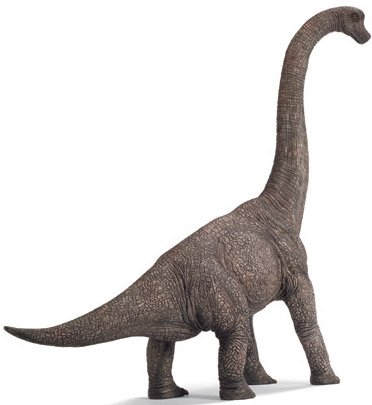Just how big was Brachiosaurus?
How big was Brachiosaurus?
Our team members are frequently asked questions by young dinosaur fans. One of the Everything Dinosaur members of staff was asked the other day: “how big is Brachiosaurus and why when I look this dinosaur up in two books, different size estimates are given”?
Scientists have only the fossil bones of Brachiosaurus to study, since no one has ever seen a living brachiosaur the size ranges given for this huge sauropod do vary. Indeed, there is considerable variation in the fossil bones of those brachiosaurs found in Africa to those found in North America. So much so, that some palaeontologists have stated that the fossils from Africa may represent a completely different animal they have named Giraffatitan.
To view an article on the Brachiosaurus/Giraffatitan debate: Brachiosaurus and Giraffatitan article,
Brachiosaurus was named and described from two partial skeletons from the famous Morrison Formation in the western United States. It was formerly named by the American palaeontologist Elmer Riggs in 1903. Although, it is one of the best known of all the sauropods, its fossils are actually very rare, much rarer than its relative (another Macronarian sauropod), Camarasaurus. The Macronarian sauropods are those long-necked dinosaurs with box-like skulls. The holes in the skull representing the nasal passages are much bigger than the hole in the skull where the eye was located.
Brachiosaurus – A Gigantic Sauropod

Picture credit: Everything Dinosaur
The picture illustrates a new interpretation of Brachiosaurus introduced last year by the German model makers Schleich. The Brachiosaurus is featured in their “Schleich Saurus” range. Brachiosaurus means “arm lizard” as the forelimbs were longer than the back limbs, giving this dinosaur a giraffe-like appearance. About half the height of Brachiosaurus is due to the neck, although there is debate whether the specimen displayed in the Humboldt museum (Berlin) is actually a Brachiosaurus (see article above), the head height of this mounted skeleton is around 13 metres.
To view the Schleich prehistoric animal range and other dinosaur figures: Dinosaur and Prehistoric Animal Models.
The reason for the different sizes given in books could be because one book was published earlier than the other. This would mean that the editor and writers would not have known about latest size estimates given for this dinosaur. Different sizes could also be due to the fact that the researchers compiling the book chose to use different cited authors and palaeontologists so they published findings from different sets of data.
Brachiosaurus
The statistics for weight, length and height for this creature are open to interpretation. However, most scientists estimate that Brachiosaurus (Brachiosaurus altithorax) as an adult animal would have ranged in size from 17 – 22 metres in length, would have stood approximately 13 metres tall and weighed perhaps as much as 70 tonnes.
Fossil bones of an even bigger animal called Ultrasauros may actually turn out to be just a very big specimen of a Brachiosaurus so the dimensions and measurements given here will most likely end up being reviewed as more fossils are discovered and more research carried out.

